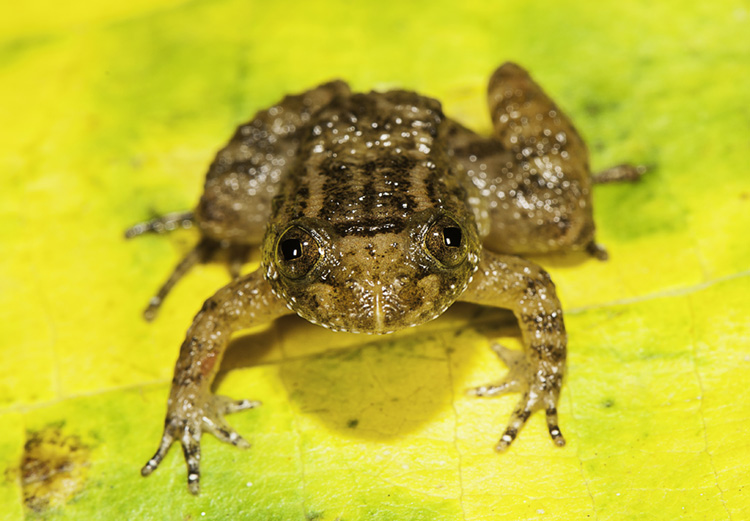Top image: A newly discovered and identified Robinmoore’s night frog (Nyctibatrachus robinmoorei) has plenty of leg room on the Indian 5-rupee coin. Credit: © SD Biju
After five years of exploration and study in the mountainous Western Ghats region of India, scientists have announced the discovery of seven new species (kinds) of frogs. Four of these new species are among the tiniest known frogs in the world, small enough to gather more than one on a 5-rupee coin (the rupee is the chief monetary unit of India). The frogs belong to the genus Nyctibatrachus with the common name of night frog—so called because of their nocturnal (active in the night) habits and dark coloring. The smallest of these newfound night frogs is less than 1/2 inch (1.2 centimeters) long!Most night frogs live in forest streams, have large webbing on their feet to swim around their aquatic habitat, and emit loud calls. Some can reach up to 3 inches (7.6 centimeters) long. Finding night frogs has never been an easy task, but the habits and smaller size of the newly found frogs make them even even more elusive. The newly discovered night frogs live mainly beneath damp soil or dense, wet vegetation, not in the water like most night frogs. They are also much quieter than other night frogs, featuring an insectlike call similar to the chirp of a cricket. Plus, four out of the seven species are extremely small. It is no wonder they went undiscovered for so long! Because they live mainly out of water, these new frog species—which have proved to be surprisingly abundant in the Western Ghats—have little or no webbing on their feet.

The newly found Athirappilly night frog (Nyctibatrachus athirappillyensis) comes from areas along the Athirappilly Falls on the Chalakudy River, site of a proposed hydroelectric dam. Credit: © SD Biju
The first frogs appeared on Earth during the Jurassic Period, which lasted from about 200 million years ago to about 145 million years ago. Thousands of species of frogs have evolved (developed over time) from these early ancestors. Night frogs are found only in southern parts of the Western Ghats region of India and represent an ancient group of frogs that populated the region about 70 million to 80 million years ago. Unfortunately, one-third of the frogs in the Western Ghats region are threatened with extinction. Increased conservation efforts are needed to protect these new species as well as other night frogs from threats posed by habitat loss, pollution, and climate change.
Untitled Document Can't view the linked articles? Subscribe to World Book Online

World Book Online delivers a progressive sequence of core databases supported by supplemental
tools, such as language translation, graphic organizers, and unique Webquests. Moving from
Early World of Learning to World Book Advanced, World Book Online aligns end-users with their
appropriate learning levels. Each stand-alone site provides additional features to support the
needs of users’ specific capabilities.
The World Book Difference
World Book combines cutting-edge technology with traditional editorial excellence to produce
authoritative, trustworthy, and unbiased content. The digital content is updated in real time and
carefully curated for each learning level. Accessible 24/7, the content is available on a variety of devices.
World Book Online combines 21st-century instructional techniques with timely information.
By breaking down complex topics and using easily understandable text, World Book Online helps to
build fluency and increase comprehension. Featuring single sign-on capability, these sites are paired
with highly visual content to engage even the most reluctant reader. Our collection of resources kindles
a lifelong learning experience for every user. This adherence to clarity, currency, and accuracy makes
World Book’s digital offerings an information hub for the classroom, library, and beyond.